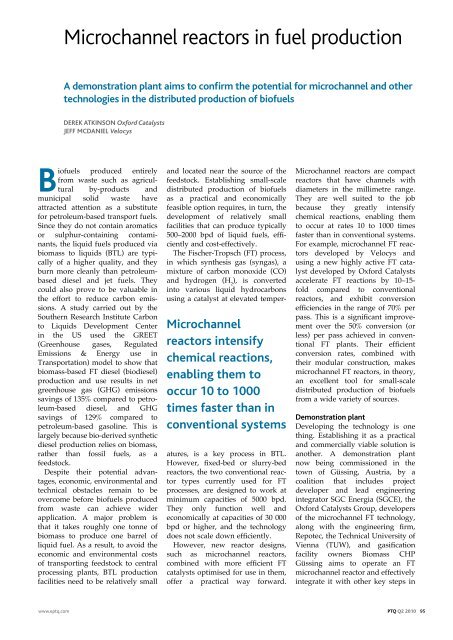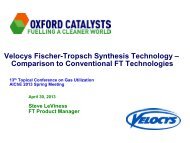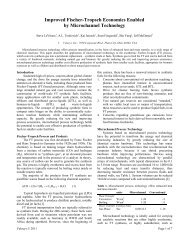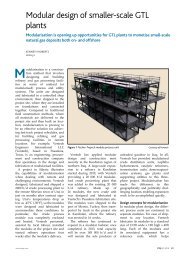Microchannel reactors in fuel production - Oxford Catalysts Group
Microchannel reactors in fuel production - Oxford Catalysts Group
Microchannel reactors in fuel production - Oxford Catalysts Group
Create successful ePaper yourself
Turn your PDF publications into a flip-book with our unique Google optimized e-Paper software.
<strong>Microchannel</strong> <strong>reactors</strong> <strong>in</strong> <strong>fuel</strong> <strong>production</strong><br />
A demonstration plant aims to confirm the potential for microchannel and other<br />
technologies <strong>in</strong> the distributed <strong>production</strong> of bio<strong>fuel</strong>s<br />
Derek Atk<strong>in</strong>son <strong>Oxford</strong> <strong>Catalysts</strong><br />
Jeff McDaniel Velocys<br />
Bio<strong>fuel</strong>s produced entirely<br />
from waste such as agricultural<br />
by-products and<br />
municipal solid waste have<br />
attracted attention as a substitute<br />
for petroleum-based transport <strong>fuel</strong>s.<br />
S<strong>in</strong>ce they do not conta<strong>in</strong> aromatics<br />
or sulphur-conta<strong>in</strong><strong>in</strong>g contam<strong>in</strong>ants,<br />
the liquid <strong>fuel</strong>s produced via<br />
biomass to liquids (BTL) are typically<br />
of a higher quality, and they<br />
burn more cleanly than petroleumbased<br />
diesel and jet <strong>fuel</strong>s. They<br />
could also prove to be valuable <strong>in</strong><br />
the effort to reduce carbon emissions.<br />
A study carried out by the<br />
Southern Research Institute Carbon<br />
to Liquids Development Center<br />
<strong>in</strong> the US used the GREET<br />
(Greenhouse gases, Regulated<br />
Emissions & Energy use <strong>in</strong><br />
Transportation) model to show that<br />
biomass-based FT diesel (biodiesel)<br />
<strong>production</strong> and use results <strong>in</strong> net<br />
greenhouse gas (GHG) emissions<br />
sav<strong>in</strong>gs of 135% compared to petroleum-based<br />
diesel, and GHG<br />
sav<strong>in</strong>gs of 129% compared to<br />
petroleum-based gasol<strong>in</strong>e. This is<br />
largely because bio-derived synthetic<br />
diesel <strong>production</strong> relies on biomass,<br />
rather than fossil <strong>fuel</strong>s, as a<br />
feedstock.<br />
Despite their potential advantages,<br />
economic, environmental and<br />
technical obstacles rema<strong>in</strong> to be<br />
overcome before bio<strong>fuel</strong>s produced<br />
from waste can achieve wider<br />
application. A major problem is<br />
that it takes roughly one tonne of<br />
biomass to produce one barrel of<br />
liquid <strong>fuel</strong>. As a result, to avoid the<br />
economic and environmental costs<br />
of transport<strong>in</strong>g feedstock to central<br />
process<strong>in</strong>g plants, BTL <strong>production</strong><br />
facilities need to be relatively small<br />
<strong>Microchannel</strong><br />
<strong>reactors</strong> <strong>in</strong>tensify<br />
chemical reactions,<br />
enabl<strong>in</strong>g them to<br />
occur 10 to 1000<br />
times faster than <strong>in</strong><br />
conventional systems<br />
and located near the source of the<br />
feedstock. Establish<strong>in</strong>g small-scale<br />
distributed <strong>production</strong> of bio<strong>fuel</strong>s<br />
as a practical and economically<br />
feasible option requires, <strong>in</strong> turn, the<br />
development of relatively small<br />
facilities that can produce typically<br />
500–2000 bpd of liquid <strong>fuel</strong>s, efficiently<br />
and cost-effectively.<br />
The Fischer-Tropsch (FT) process,<br />
<strong>in</strong> which synthesis gas (syngas), a<br />
mixture of carbon monoxide (CO)<br />
and hydrogen (H 2<br />
), is converted<br />
<strong>in</strong>to various liquid hydrocarbons<br />
us<strong>in</strong>g a catalyst at elevated temperatures,<br />
is a key process <strong>in</strong> BTL.<br />
However, fixed-bed or slurry-bed<br />
<strong>reactors</strong>, the two conventional reactor<br />
types currently used for FT<br />
processes, are designed to work at<br />
m<strong>in</strong>imum capacities of 5000 bpd.<br />
They only function well and<br />
economically at capacities of 30 000<br />
bpd or higher, and the technology<br />
does not scale down efficiently.<br />
However, new reactor designs,<br />
such as microchannel <strong>reactors</strong>,<br />
comb<strong>in</strong>ed with more efficient FT<br />
catalysts optimised for use <strong>in</strong> them,<br />
offer a practical way forward.<br />
<strong>Microchannel</strong> <strong>reactors</strong> are compact<br />
<strong>reactors</strong> that have channels with<br />
diameters <strong>in</strong> the millimetre range.<br />
They are well suited to the job<br />
because they greatly <strong>in</strong>tensify<br />
chemical reactions, enabl<strong>in</strong>g them<br />
to occur at rates 10 to 1000 times<br />
faster than <strong>in</strong> conventional systems.<br />
For example, microchannel FT <strong>reactors</strong><br />
developed by Velocys and<br />
us<strong>in</strong>g a new highly active FT catalyst<br />
developed by <strong>Oxford</strong> <strong>Catalysts</strong><br />
accelerate FT reactions by 10–15-<br />
fold compared to conventional<br />
<strong>reactors</strong>, and exhibit conversion<br />
efficiencies <strong>in</strong> the range of 70% per<br />
pass. This is a significant improvement<br />
over the 50% conversion (or<br />
less) per pass achieved <strong>in</strong> conventional<br />
FT plants. Their efficient<br />
conversion rates, comb<strong>in</strong>ed with<br />
their modular construction, makes<br />
microchannel FT <strong>reactors</strong>, <strong>in</strong> theory,<br />
an excellent tool for small-scale<br />
distributed <strong>production</strong> of bio<strong>fuel</strong>s<br />
from a wide variety of sources.<br />
Demonstration plant<br />
Develop<strong>in</strong>g the technology is one<br />
th<strong>in</strong>g. Establish<strong>in</strong>g it as a practical<br />
and commercially viable solution is<br />
another. A demonstration plant<br />
now be<strong>in</strong>g commissioned <strong>in</strong> the<br />
town of Güss<strong>in</strong>g, Austria, by a<br />
coalition that <strong>in</strong>cludes project<br />
developer and lead eng<strong>in</strong>eer<strong>in</strong>g<br />
<strong>in</strong>tegrator SGC Energia (SGCE), the<br />
<strong>Oxford</strong> <strong>Catalysts</strong> <strong>Group</strong>, developers<br />
of the microchannel FT technology,<br />
along with the eng<strong>in</strong>eer<strong>in</strong>g firm,<br />
Repotec, the Technical University of<br />
Vienna (TUW), and gasification<br />
facility owners Biomass CHP<br />
Güss<strong>in</strong>g aims to operate an FT<br />
microchannel reactor and effectively<br />
<strong>in</strong>tegrate it with other key steps <strong>in</strong><br />
www.eptq.com PTQ Q2 2010 95
tion technology. The developments<br />
<strong>in</strong> Güss<strong>in</strong>g led to the establishment<br />
of the Renewable Energy Network<br />
Austria (RENET). As a result,<br />
Güss<strong>in</strong>g has become a magnet for<br />
companies and researchers keen<br />
to develop renewable energy<br />
technologies.<br />
Other factors determ<strong>in</strong>ed the<br />
choice of Güss<strong>in</strong>g as the site for a<br />
demonstration of FT microchannel<br />
bio<strong>fuel</strong>s <strong>production</strong> technology.<br />
These <strong>in</strong>cluded the enthusiasm<br />
expressed by the local technology<br />
community as well as the availability<br />
of a new test facility and R&D<br />
build<strong>in</strong>g with the utilities <strong>in</strong> place<br />
for SGCE to <strong>in</strong>stall the FT and gas<br />
condition<strong>in</strong>g skids necessary for its<br />
trial. Güss<strong>in</strong>g is also home to a<br />
gasification plant that has been<br />
operat<strong>in</strong>g <strong>in</strong> a stable manner for<br />
seven years (Figure 1). The syngas<br />
result<strong>in</strong>g from this gasification<br />
process has the necessary characteristics<br />
and high H 2<br />
/CO ratio<br />
required for FT.<br />
Figure 1 The Güss<strong>in</strong>g gasification plant<br />
the BTL process, <strong>in</strong>clud<strong>in</strong>g biomass<br />
gasification and syngas clean<strong>in</strong>g.<br />
In the late 1980s, the town of<br />
Güss<strong>in</strong>g, located <strong>in</strong> southern<br />
Austria near the borders of<br />
Hungary and Slovenia, was the<br />
adm<strong>in</strong>istrative centre of the poorest<br />
region <strong>in</strong> Austria. Then, <strong>in</strong> the<br />
1990s, the city developed a model<br />
to replace energy dependence on<br />
fossil <strong>fuel</strong>s with renewable sources.<br />
By 2001, Güss<strong>in</strong>g had achieved<br />
energy self-sufficiency through the<br />
<strong>in</strong>stallation of a biomass plant that<br />
takes advantage of steam gasifica-<br />
<strong>Microchannel</strong> process<br />
technology module<br />
FT<br />
Courtesy: SGCE<br />
Boil<strong>in</strong>g heat transfer<br />
High heat flux<br />
10 times higher heat flux<br />
than conventional <strong>reactors</strong><br />
0.01” – 0.20”<br />
0.01” – 0.20”<br />
Figure 2 In a microchannel reactor, a s<strong>in</strong>gle reactor module consists of hundreds of<br />
rows of microchannels each conta<strong>in</strong><strong>in</strong>g large numbers of parallel microchannels. The<br />
orientation and size of the channels with<strong>in</strong> each row is determ<strong>in</strong>ed by the application,<br />
adjacent rows of channels potentially hav<strong>in</strong>g different duties<br />
Courtesy: Velocys<br />
Reduced dimensions<br />
<strong>Microchannel</strong> process technology is<br />
a develop<strong>in</strong>g field of chemical<br />
process<strong>in</strong>g that enables rapid reaction<br />
rates by m<strong>in</strong>imis<strong>in</strong>g heat and<br />
mass transport limitations, particularly<br />
<strong>in</strong> highly exothermic or<br />
endothermic reactions. This is<br />
achieved by reduc<strong>in</strong>g the dimensions<br />
of the reactor systems. In<br />
microchannel <strong>reactors</strong>, the key<br />
process steps are carried out <strong>in</strong><br />
parallel arrays of microchannels,<br />
each with typical dimensions <strong>in</strong> the<br />
range 0.1–5mm (see Figure 2). This<br />
modular structure enables reduction<br />
<strong>in</strong> the size and cost of the<br />
chemical process<strong>in</strong>g hardware.<br />
When microchannel technology is<br />
employed, plant size is small.<br />
Conventional FT <strong>reactors</strong> are up to<br />
60m tall. In contrast, microchannel<br />
reactor assemblies are roughly 1.5m<br />
<strong>in</strong> diameter, have a low profile and<br />
sit horizontally. Their modularity<br />
and productivity make them<br />
convenient for use <strong>in</strong> small-scale<br />
bio<strong>fuel</strong>s <strong>production</strong> plants, and also<br />
opens up the possibility for their<br />
use on offshore platforms to<br />
produce liquid <strong>fuel</strong> via gas to<br />
liquids (GTL) processes.<br />
<strong>Microchannel</strong> FT reactor design is<br />
also flexible. For example, where<br />
<strong>in</strong>creas<strong>in</strong>g the size of conventional<br />
<strong>reactors</strong> normally requires plant<br />
designers to <strong>in</strong>crease the size of<br />
each reactor unit, which alters flow<br />
and reaction dynamics <strong>in</strong> the reactor,<br />
the modular structure of<br />
microchannel <strong>reactors</strong> means that<br />
<strong>in</strong>creas<strong>in</strong>g plant size to build<br />
demonstration or even commercialsized<br />
plants can be done by<br />
“number<strong>in</strong>g up”. This <strong>in</strong>volves<br />
simply add<strong>in</strong>g more <strong>reactors</strong> with<br />
the same dimensions. In conventional<br />
FT plants, scal<strong>in</strong>g up typically<br />
96 PTQ Q2 2010 www.eptq.com
<strong>in</strong>volves a lot of fabrication <strong>in</strong> the<br />
field, as well as respecification of<br />
reaction conditions and plant<br />
components. This can be both<br />
expensive and time-consum<strong>in</strong>g. In<br />
contrast, microchannel <strong>reactors</strong> can<br />
be shop-fabricated, so microchannelbased<br />
plants can be constructed<br />
more quickly and easily, thus<br />
reduc<strong>in</strong>g setup costs and the risks<br />
associated with scal<strong>in</strong>g up <strong>in</strong><br />
conventional <strong>reactors</strong>.<br />
Modular construction also makes<br />
the plants more durable and easier<br />
to service because ma<strong>in</strong>tenance and<br />
catalyst replacement can be carried<br />
out by replac<strong>in</strong>g <strong>in</strong>dividual<br />
modules, rather than requir<strong>in</strong>g a<br />
prolonged shutdown of the entire<br />
system. F<strong>in</strong>ally, the overall capital<br />
costs associated with FT microchannel<br />
<strong>reactors</strong> are relatively low<br />
compared to conventional reactor<br />
systems such as slurry beds.<br />
Process <strong>in</strong>tensification<br />
The performance of microchannel<br />
<strong>reactors</strong> is attributable to their<br />
process-<strong>in</strong>tensified design, which<br />
results <strong>in</strong> enhanced heat and mass<br />
transfer capabilities (see Table 1).<br />
Conventional reactor systems rely<br />
on the use of bulky hardware to<br />
manage the heat <strong>in</strong> FT reactions,<br />
and they have relatively small heat<br />
transfer areas per volume of catalyst.<br />
In contrast, <strong>in</strong> microchannel<br />
<strong>reactors</strong>, each reactor block has<br />
thousands of th<strong>in</strong> process channels<br />
filled with FT catalyst, which are<br />
<strong>in</strong>terleaved with water-filled coolant<br />
channels. As a result, they are<br />
able to dissipate the heat produced<br />
from the exothermic FT reaction<br />
much more quickly than conventional<br />
systems.<br />
This makes them suitable for<br />
carry<strong>in</strong>g out both highly exothermic<br />
catalytic reactions, such as FT<br />
synthesis, and highly endothermic<br />
reactions, such as steam methane<br />
reform<strong>in</strong>g (SMR), <strong>in</strong> which heat<br />
must be efficiently transferred<br />
across reactor walls <strong>in</strong> order to<br />
ma<strong>in</strong>ta<strong>in</strong> an optimal and uniform<br />
temperature, to maximise the catalyst<br />
activity and prolong catalyst<br />
life. This allows microchannel <strong>reactors</strong><br />
to operate at much higher<br />
throughput and productivity.<br />
As a result, microchannel process<br />
<strong>Microchannel</strong><br />
conventional<br />
Heat transfer, W/cm 2<br />
Convective 1–20
co-precipitation <strong>in</strong> a range of base<br />
metal catalysed reactions. Aside<br />
from their higher activity, the catalysts<br />
have a longer life and the need<br />
for precious metal promoters on the<br />
catalysts can be reduced, or <strong>in</strong> some<br />
cases elim<strong>in</strong>ated, while still reta<strong>in</strong><strong>in</strong>g<br />
or even exceed<strong>in</strong>g the benefits<br />
of more conventional catalysts.<br />
Work is currently <strong>in</strong> hand to scale<br />
up the process to make it possible<br />
to supply formed catalysts <strong>in</strong><br />
commercial quantities.<br />
Figure 4 Transmission electron microscope picture of the FT catalyst produced us<strong>in</strong>g the<br />
OMX method<br />
combustion (OMX). The OMX<br />
method comb<strong>in</strong>es the metal salt and<br />
an organic component to make a<br />
complex that effectively stabilises<br />
the metal. On calc<strong>in</strong>ation, combustion<br />
occurs to fix the crystallites at<br />
a very small size and <strong>in</strong> a very<br />
narrow range. S<strong>in</strong>ce the calc<strong>in</strong>ation<br />
step is quick, metal crystallites do<br />
not have time to grow and hence<br />
rema<strong>in</strong> at an appropriate size for<br />
these types of catalytic reactions.<br />
This is important, because the level<br />
of catalyst activity, selectivity and<br />
stability is related to the surface<br />
area of the catalyst. This, <strong>in</strong> turn, is<br />
related to crystal size, so produc<strong>in</strong>g<br />
catalysts with the optimal crystal<br />
size for a given application is a key<br />
goal for catalyst developers. The<br />
big challenge lies <strong>in</strong> achiev<strong>in</strong>g the<br />
right balance between catalyst activity<br />
and stability. If the crystal size<br />
is too large, the catalyst activity<br />
and, hence, conversion rates are<br />
reduced. If too small, the catalyst<br />
becomes unstable.<br />
The OMX method produces crystallites<br />
that exhibit a terraced<br />
surface (see Figure 4), which<br />
enhances catalyst activity. OMX<br />
also produces fewer very small<br />
crystallites that could s<strong>in</strong>ter at an<br />
early stage of operation. This results<br />
<strong>in</strong> greater catalyst stability. Less<br />
stable crystallites tend to deactivate<br />
quickly, reduc<strong>in</strong>g the activity of the<br />
catalysts.<br />
The method can be used to<br />
<strong>Microchannel</strong><br />
technology shr<strong>in</strong>ks<br />
process<strong>in</strong>g hardware,<br />
while at the same<br />
time improv<strong>in</strong>g its<br />
performance<br />
produce supported base metal catalysts<br />
for applications other than<br />
those produced for FT. Evaluations<br />
<strong>in</strong>dicate that catalysts prepared via<br />
OMX perform better than catalysts<br />
conta<strong>in</strong><strong>in</strong>g the same metals but<br />
prepared us<strong>in</strong>g standard methods,<br />
such as mechanical mill<strong>in</strong>g, wet or<br />
dry impregnation, or via sol-gel or<br />
Scal<strong>in</strong>g down<br />
An essential characteristic required<br />
for distributed bio<strong>fuel</strong>s <strong>production</strong><br />
is the ability to operate efficiently<br />
on a small scale. <strong>Microchannel</strong><br />
technology shr<strong>in</strong>ks process<strong>in</strong>g hardware,<br />
while at the same time<br />
improv<strong>in</strong>g its performance. As well<br />
as improved heat transfer properties<br />
and higher energy efficiency,<br />
microchannel design enables optimal<br />
temperature control across the<br />
catalyst bed, which maximises catalyst<br />
activity and life by prevent<strong>in</strong>g<br />
the formation of hotspots. It also<br />
results <strong>in</strong> higher reactor productivity<br />
as well as <strong>in</strong>creased economies<br />
of scale and <strong>in</strong>creased yields of<br />
target products. The reduction <strong>in</strong><br />
the reactant residence time achieved<br />
us<strong>in</strong>g microchannel reactor technology<br />
also means <strong>in</strong>herently safer<br />
operation.<br />
Another advantage of microchannel<br />
<strong>reactors</strong> is their capability to<br />
handle large volumes of feedstock<br />
and their ability to produce quality<br />
<strong>fuel</strong>s from a variety of resources,<br />
<strong>in</strong>clud<strong>in</strong>g waste wood and municipal<br />
solid waste. In terms of<br />
productivity, they far outstrip more<br />
conventional designs and could<br />
help enable the distributed <strong>production</strong><br />
of next-generation bio<strong>fuel</strong>s to<br />
become a viable economic reality<br />
and a practical way to reduce<br />
carbon emissions <strong>in</strong> the near future.<br />
Derek Atk<strong>in</strong>son is the Bus<strong>in</strong>ess Development<br />
Director responsible for the petroleum and<br />
petrochemical markets at <strong>Oxford</strong> <strong>Catalysts</strong> Ltd,<br />
part of the <strong>Oxford</strong> <strong>Catalysts</strong> <strong>Group</strong>, <strong>Oxford</strong>.<br />
Email: Derek.Atk<strong>in</strong>son@oxfordcatalysts.com<br />
Jeff McDaniel is the Bus<strong>in</strong>ess Development<br />
Director for Velocys Inc, Columbus, Ohio, part<br />
of the <strong>Oxford</strong> <strong>Catalysts</strong> <strong>Group</strong>.<br />
Email: mcdaniel@velocys.com<br />
98 PTQ Q2 2010 www.eptq.com











